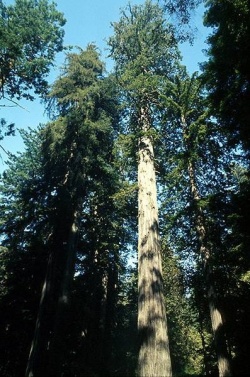Cypress
| Cupressaceae |
|---|

|
| Scientific Classification |
|
| Genera |
|
Cypress are conifer trees belonging to the taxonomic family Cupressaceae is a group of conifers that is able to live in just about every part of the world. More commonly, people call the family Cupressaceae the Cypress family. In this family there are 30 genera and about 135 species. Some of the better known genuses are Cypress, Juniper, Sequoia or Redwood. One of the most famous species is the Coastal Redwood, which also happens to be the tallest tree in the world. These trees are found primarily along the coast of California. These trees are giants and can grow to be over 300 feet tall, and some are over 2000 years old. The family Cupressaceae also contains the second largest tree in the world, the Giant Sequoia. The largest known tree in the world is a Giant Sequoia named General Sherman at 274.9 feet tall, with a circumference of 102.6 feet.
Anatomy
The size range for members of Cupressaceae is quite large. Species vary between one and one-hundred twelve meters in height. The common colors of bark are orange to red-brown. Bark is often stringy and smooth in texture and runs vertically up the tree. Some species have bark that breaks into squares on the side of the tree, and is rougher than usual.
On younger trees, leaves are small needles. They stick out at about ninety degrees on each side of the twig. As they get older the needles become small and scales like. As a tree gets older, its needles do not fall of individually, but they fall off in groups or clusters. Since the majority of the members in Cupressaceae are evergreen, needles don’t fall for up to 10 years. There are a few species that shed needles or leaves yearly.
Reproduction
Most of the trees and shrubs in the family Cupressaceae are monoecious (have male and female flowers on the same plant), while a smaller number are dioecious (have male and female flowers on separate plants). Members of Cupressaceae generally have two different types of cones - female and male. One is a tough, woody, and leathery outside while the other is a fleshy outside respectively. Each separate scale on the female cone normally has several seeds. Pollination in Cupressaceae normally happens in late winter or early spring, but it can occur anywhere from late summer to early winter for certain species. Some species of Cupressaceae have cones that will remain dormant for years, some only opening after exposure to fire.
Ecology
The members of Cupressaceae are one of the most widespread families of plants in the world. They are found on every continent except for Antarctica, and they are found in great quantity too. They are also able to live higher than any other trees in the world. Some members have been found at 5200 meters altitude in Tibet.
The heartwood of most members of Cupressaceae is very resitant to termite and fungus damage. Because of this, it is a prime choice to be used when in contact with dirt. It is also used for lawn furniture, coffins, and fence posts, since they are also in contact with the ground. Since almost all heartwood of Cupressaceae smells of cedar, it is commonly used as a cheap replacement.
Gopher Wood
- Main Article: Gopher wood
In the Bible's book of Genesis we read that God told Noah to build an ark of "gopher wood". Many modern study guides say that gopher wood was probably cypress or cedar. However, Hebrew experts do not knows for sure what gopher wood is in modern terminology. Dr. Henry Morris said in his Defender's Study Bible (1995) that the ark was made of "a hard dense wood whose species has not yet been identified."
References
- Cupressaceae Dr. Gerald (Gerry) Carr
- Cupressaceae Wikipedia
- Cupressaceae Rich. ex Bartling 1830 Michael P. Frankis
Gallery
Rottnest Island pine
(C. preissii)
Genus: CallitrisWestern juniper
(J. occidentalis)
Genus: JuniperusDawn redwood
(M. glyptostroboides)
Genus: MetasequoiaGiant sequoia
( S. giganteum)
Genus: SequoiadendronNorthern whitecedar
(T. occidentalis)
Genus: ThujaBald cypress
(T. distichum)
Genus: Taxodium






